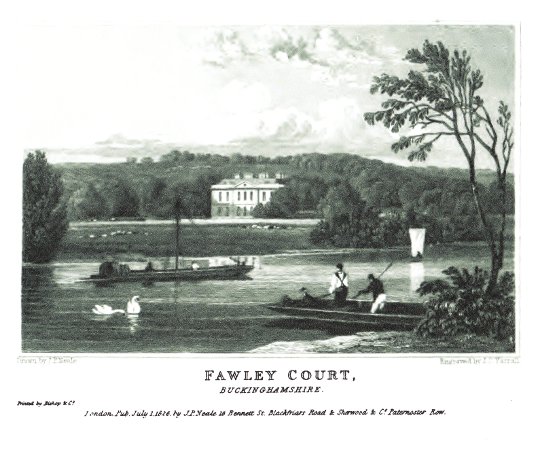 |
 |
| Aktualnie jeste¶: |
|
|
|
History before 1953 |

David C. Whitehead,
Fawley Court
At the time of Doomsday Book, the manor of Fawley was held by Walter Gifford, the Earl of Buckingham. Later, in the 1100s, the Sackville family built a fortified manor house on the site of the present Fawley Court and lived there until the late 1400s. In 1616, Fawley Manor, which at that time was probably a large medieval house, was purchased by Sir James Whitelock. He was a lawyer who was Commissioner of the Peace for Buckinghamshire and later for Oxfordshire as well but, despite these appointments, he favoured some curtailment of royalty`s freedom of action. He was highly respected in Henley and on several occasions the Corporation presented him with gifts such as haunches of venison. After his death in 1632 and burial in Fawley church, King Charles I referred to him as “a stout wise and learned judge”. His son, Sir Bulstrode Whitelock, inherited Fawley Court and Manor, and he also bought Phyllis Court and the title of the lord of the manor of Henley. At the time of the Civil War, Sir Bulstrode supported the Parliamentarian cause and fought in the army under Cromwell. However, Fawley Court was severely damaged by Royalist troops, who occupied it for a time. Subsequently, Sir Bulstrode Whitelock became Governor of Henley and was appointed by Cromwell to various posts which included being ambassador to Sweden. After the restoration of Charles II, he was heavily fined for his part in the Civil War, though it is possible that this was, at least partly, revoked. Sir Bulstrode retired to his house in Wiltshire and passed the ownership of the damaged Fawley Court to his eldest son James, but no repairs were carried out and in 1680 it was sold to a Colonel William Freeman.
Colonel Freeman had a new house (the present one) built in 1684, in a style made fashionable by Christopher Wren, who was a friend of his. Freeman had fought with Bulstrode Whitelock in the Civil War and had since become wealthy, particularly by trading in sugar from his estates, manned by slaves, in the West Indies. His wealth enabled him to have the house rebuild, and to decorate and furnish it to a high standard, as well as improve the appearance of the grounds. Some of the interior decoration was carried out by Grinling Gibbson, and it is possible that “Capability” Brown was involved in the landscaping of the parkland. Around 1770, Sambrooke Freeman, who had inherited the estate, bought the adjacent property of Phyllis Court. He also commissioned James Wyatt to create an appropriate summer house, and the result was the temple, just visible from Henley Bridge, that gives its name to Temple Island. This project was part of a trend for the owners of country houses to create the appearance of natural landscapes in their estates and then to add “picturesque” and classical features. Sambrook Freeman`s enthusiasm for this style was probably gained during his travels in Italy, and was reinforced by his becoming a member of the Society of Arts. During his time at Fawley Court, it was the venue for many social events, including musical dinners organised by Mrs. Freeman. Both George II and George IV visited the house on several occasions.
When Sambrook Freeman died, a nephew, Strickland freeman, inherited the estate which then remained in the ownership of the Freeman family until it was sold in 1853 to Edward MacKenzie. He was a Scottish banker and his son, William D. MacKenzie (1840-1928), a surveyor and railway engineer, added the side wing to the house in 1884. He also created the canal-like waterway from the house to the Thames, planted more trees and restocked the deer park, but transferred the manorial rights of Henley manor to the Henley Corporation. His son, Major William R.D. MacKenzie, sold much of the estate in 1931-2 but remained owner of the house.
During the Second World War the house was requisitioned by the army and used as a centre for training prospective undercover agents in wireless communication. Major MacKenzie was given only one week`s notice to move out, and so hurriedly had to pack up his more valuable furniture and decorative items and store them in the basement and outbuildings. The army left the house in poor condition but Major MacKenzie returned and lived there until his death in 1952. The estate, including Henley Park, was then subdivided and put up for sale in a number of lots, but because of its size and condition the main house at Fawley Court was threatened with demolition. However, it was bought in 1953 by the Polish Congregation of Marian Fathers who founded a Catholic secondary school for boys, most of whom had parents of Polish origin. The school closed in 1986 and the Marian Fathers then converted the house for use as a religious retreat and conference centre. They also allocated some rooms for a museum, which included items used by the Polish army in past centuries, together with a library containing historic Polish documents, early books and paintings.`` ,
Henley-on-Thames A History, Phillimore 2007
|
|
|
|
Komitet Obrony Dziedzictwa Narodowego Fawley Court, , e-mail: savefawley@hotmail.com |
|


